
Hawks: Amazing Facts for Kids about the Broad-Winged Raptors
“It is unwise for one to think that a hen will ever be accorded respect in the land of the hawks.”
African Proverb
We can pretty much classify animals according to different aspects. In biology, the standard sequence is the taxonomy hierarchy which divides all organisms based on eight categories that go from broad to specific.
The most general rank is the domain, and the most specific one is species. For instance, all land and sea animals, birds, plants, and humans belong to the Eukarya domain. However, we are one species, and every single land and sea animal, bird, and plant is an independent species.
This taxonomy hierarchy is complicated and more critical for biologists than for the masses. In that respect, there is another more straightforward way to classify animals that many people can understand. That is to divide them into predators and prey.
Predator or prey
Predators are those strong and aggressive animals that usually attack other animals to feed on them. Prey, on the other hand, are those animals that get attacked and eaten.
Prey animals do not necessarily have to be weak and small. In fact, many, many animals can be both predators and prey. They feed on some animals, and others feed on them.
This is called the food chain, which connects all living things. And who could describe it better than Mufasa from The Lion King (1994)? If you remember closely, while he was showing Simba their kingdom, he said, “When we die, our bodies become the grass, and the antelope eats the grass. And so we are all connected in the great Circle of Life.”
As a result, he concluded, “Everything [we] see exists together in a delicate balance.”
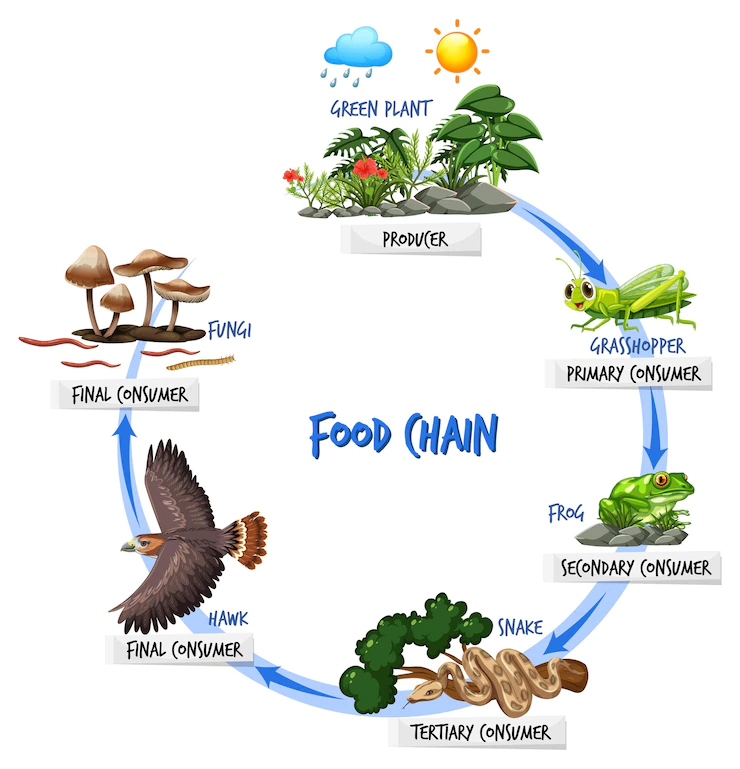
With that in mind, some animals are neither prey nor predators, for example, the elephant. Its enormous body protects it from predators sharing its natural habitat, such as lions and cheetahs—at least against their individual attacks.
Some animals are prey only; again, it has little to do with size. Rabbits are prey, as well as zebras. Likewise, other animals are predators only that have no natural predators. Those are called apex predators.
As you might have guessed, apex predators are on top of the food chain. They prey on other animals, but no other animal ever preys on them. We can also conclude that apex predators only eat meat. Animals which eat meat only are commonly referred to as carnivores.
In biology, the word animal does not refer to land animals only. Still, it also includes fish, reptiles, and birds. Therefore, apex predators can be land animals, for example, the lion, the cheetah, and the jaguar or reptiles, such as crocodiles and snakes.
In the same way, sharks, leopard seals, and killer whales are water apex predators, and eagles, vultures, owls, and hawks are birdy apex predators.
And hawks are what we are discussing today.
Hawks
Hawks are known as birds of prey. That does not mean they themselves are prey, but they feed on prey. Hawks and other birds of prey are also called raptors.
Collectively, there are about 270 species of hawks that belong to a large subfamily called Accipitridae. Over 60 of them live in Asia, and 19 species are found in North America. Members of this subfamily mainly feed on birds they hunt in their woodland habitat.
While all the hawk species are indeed different in many traits, such as the size, they share a lot of common ones as well.
For example, all hawks are characterised by their unbelievably broad, strong wings, beautifully coloured feathers, intense eyes, hooked beaks, and sharp curved claws, which are known as talons. Hawks are also known for their intelligence and excellent hunting skills.
Hawks are pretty much found all over the world except for the southernmost, frozen continent of Antarctica. But they do not live just anywhere in the world. For instance, it is rare to see hawks in cities living alongside humans. As they feed on other animals, hawks are usually found in mountain plains, deserts, forests, open fields, and woodlands.
Like horses and ponies, many mistake hawks for falcons or vice versa. But hawks and falcons are not the same bird. Despite looking so much alike, there are apparent differences between them that may help you tell them apart.
For instance, falcons are typically smaller than hawks. While falcons have relatively thin and pointed wings, hawks, on the other hand, have their wings broader and rounder. But one cannot spot such a difference unless the bird is flying. In addition, falcons have their heads round and short, while hawks’ heads are smooth and more pointed.
Appearance
As we have just mentioned, about 270 species of hawks live worldwide, and all of them have different looks from one another. So, for the sake of this article, we will describe the largest and smallest hawks in particular before we discuss other general hawk features.
The ferruginous hawk
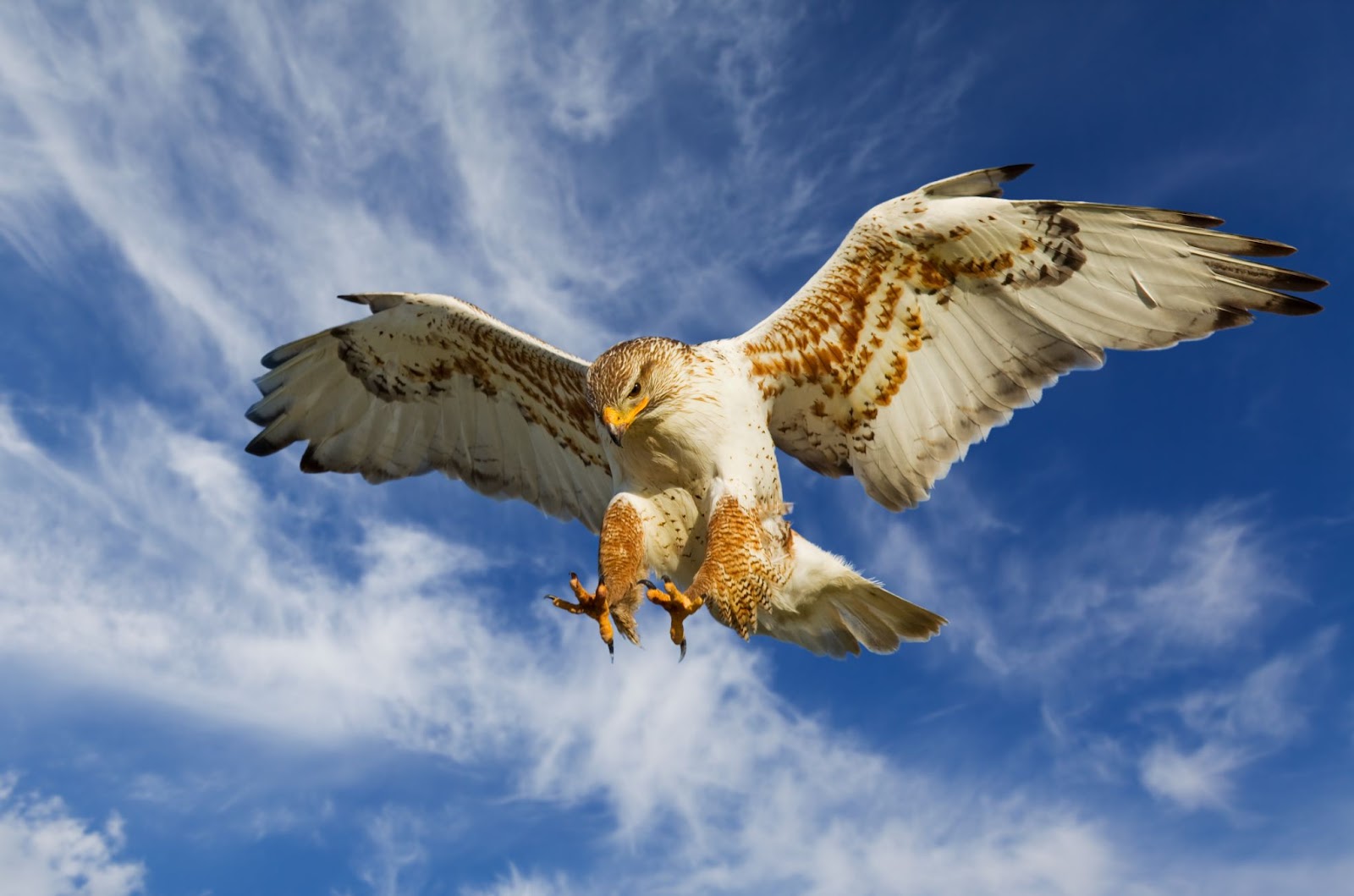
The largest hawk in the world, the ferruginous hawk, is native to North America. The name ferruginous has a Latin base that means reddish-brown or iron rust, and most of this hawk’s feathers are iron rust.
The ferruginous hawk is also characterised by its super large wings extending 122 to 152 cm from tip to tip. This is called the wingspan. Besides being the largest and the most powerful, some say the ferruginous hawk is the rarest on Earth.
Speaking of appearance, the ferruginous hawk is quite attractive. Initially, this hawk can be of two colour patterns. The most common is the light-morph ferruginous hawk. The feathers on the back, outer wings, and legs are rusty, while the underparts are white. Yes, this hawk has feathers on its legs.
When the bird is flying, those legs make a beautiful, rusty V shape on the white underparts.
On the other hand, the other group is dark-morphs. That means they have rusty or chocolate-coloured feathers all over their bodies. When seen from above while the bird is in flight, the wings are brown too. But if it is seen from below, they are half pale grey, half brown. The chest and underparts are brown, while the tail is pale grey.
Unlike many other animals and bird species, female birds of prey are typically bigger than males. So for the ferruginous hawk, females and males have a length range, from beak to tail, from 51 to 69 cm, and the wingspan is usually between 122 and 152 cm. The average weight is 1,590 g.
That said, the ferruginous hawk living in different areas in North America may have other measurements.
With those strong wings, the ferruginous hawk can fly at a maximum speed of 240 km/h.
The sharp-shinned hawk
The world’s smallest hawk is the sharp-shinned male hawk, for the female is larger than the male. Unlike the ferruginous hawk, the sharp-shinned hawk is found all over North America as well as all the Caribbean Islands, Central America, and South America.
So speaking of size, the male sharp-shinned hawk weighs 98 g on average, with 115 being its maximum weight. It has a maximum body length, from head to tail, between 23 and 30 cm. Its wingspan is 42 to 58 cm, which is pretty short compared to the ferruginous hawk.
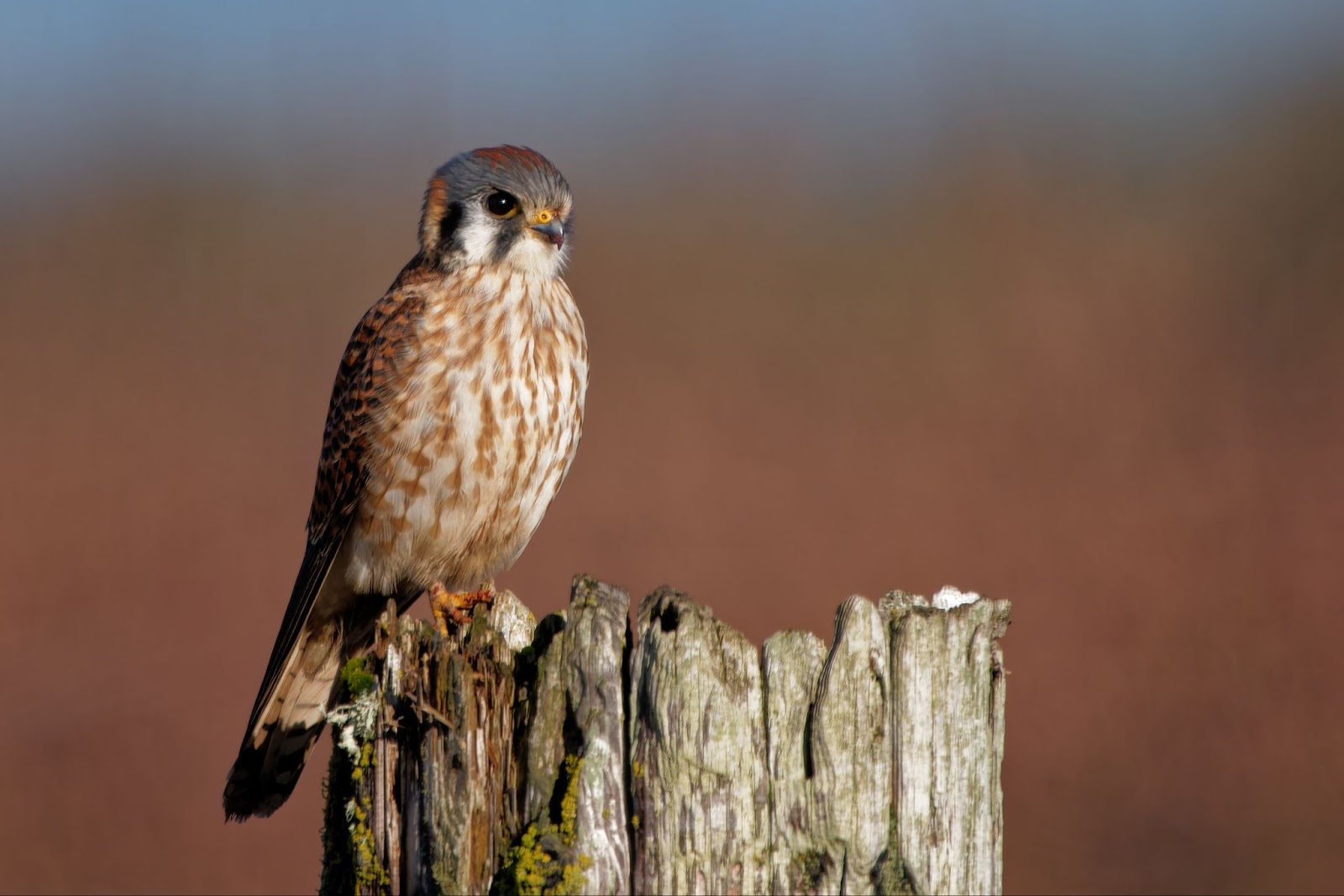
On the flip side, females range between 29 and 37 cm in body length and their wingspan is 63 on average, with the maximum limit being 68 cm. Weight-wise, females are as heavy as 150 g to 219 g.
Despite their tiny size, both male and female sharp-shinned hawks have long tails measuring 12 to 19 cm.
The sharp-shinned hawk is pretty good-looking with beautifully matching patterns of colours. The wings and back are covered with long black feathers, while the tail has a dark brown-greyish colour. The neck, chest, and belly are golden brown and white, and the area towards the tail is snow white.
Unlike the ferruginous hawk, the sharp-shinned hawk’s legs are not covered with feathers. But it has sharp eyes, a small black beak, and strong curved yellow claws.
There are four species of the sharp-shinned hawk, which might differ a little in the colour patterns and body measurements.
Feeding
Now back to the hawk as a general topic.
As they are birds of prey, hawks usually hunt and feed on small animals. So mice, rabbits, squirrels, frogs, snakes, and lizards are among their favourite food. Hawks also hunt other birds, such as quails and woodpeckers. Interestingly, hawks can catch birds while both of them are flying.
Additionally, hawks like fish. They spot them swimming toward the surface of the water while in flight. So they fly so fast toward the water and catch them using their sharp talons.
Hawks usually hunt during the day and rest at night. They wake up so early and start their day at dawn every day. They go hunting, have breakfast, and then switch back and forth between resting and hunting until they have had enough.
At dusk, which is the short period after sunset and before complete darkness, hawks become very active again and search closely for dinner. Once they have it, they rest until the following dawn.
Animals that forage during the day and rest at night are known as diurnal.
Breeding
Hawks become mature enough to mate and start a family between the ages of 1.5 and 3.
While other birds can mate at any time of the year and for a couple of times, hawks are different and more organised. They breed once per year and usually during the spring. This is called seasonal breeding.
The mating season starts in late February or early March and ends in May. Sometimes, mating can happen a little before or after this, depending on where hawks live.
Nest building
First off, hawk couples stay together for life. However, they do not ‘actually’ stay together in the same nest except during the breeding season and until their chicks learn to fly and become independent.
For the rest of the years, male and female hawks live independently in different, large nests. Where hawks choose to build their nest changes based on their habitats. Yet, the location has to be safe from attack and immune in the face of harsh wind.
So, most hawk species choose high trees with large leaves and thick, strong branches. They also prefer spots closer to tree trunks. Some species prefer to build their nest on cliffs.
On the flip side, other hawks may build their nests on the ground, but only if the area is grassy so that the nest is safe and hidden. They also pick spots which they know are not prone to visits from snakes, raccoons, or foxes. Those animals are known to steal and feed on the hawk’s eggs.
Mating
How hawks choose their partners and start their families is so interesting.
When it is time to mate, males and females fly in circles at around 300 m, displaying their beautiful feathers and soaring to attract a mate. They perform many aerial acrobatic movements to show off their skills and how good of a partner they will make.
Once a mate is attracted, both hawks engage their talons and begin free-falling to the ground. You must note that they do not fly down deliberately. But they let themselves fall, ultimately giving in to the force of gravity. This behaviour means they have accepted each other.
Once the couple reaches the ground, they mate. Then, they choose one of their two nests as home for the family. They enlarge it and make it ready for welcoming babies.
A female then becomes pregnant with one to five eggs. This number is called the clutch size. She lays the eggs one after another, but only one per day. Each egg is 5.5 to 6.8 cm long and 4 to 5 cm wide. Egg colours range from white and off-white to different hues of beige and brown. Yet, all eggs will have brown spots on them.
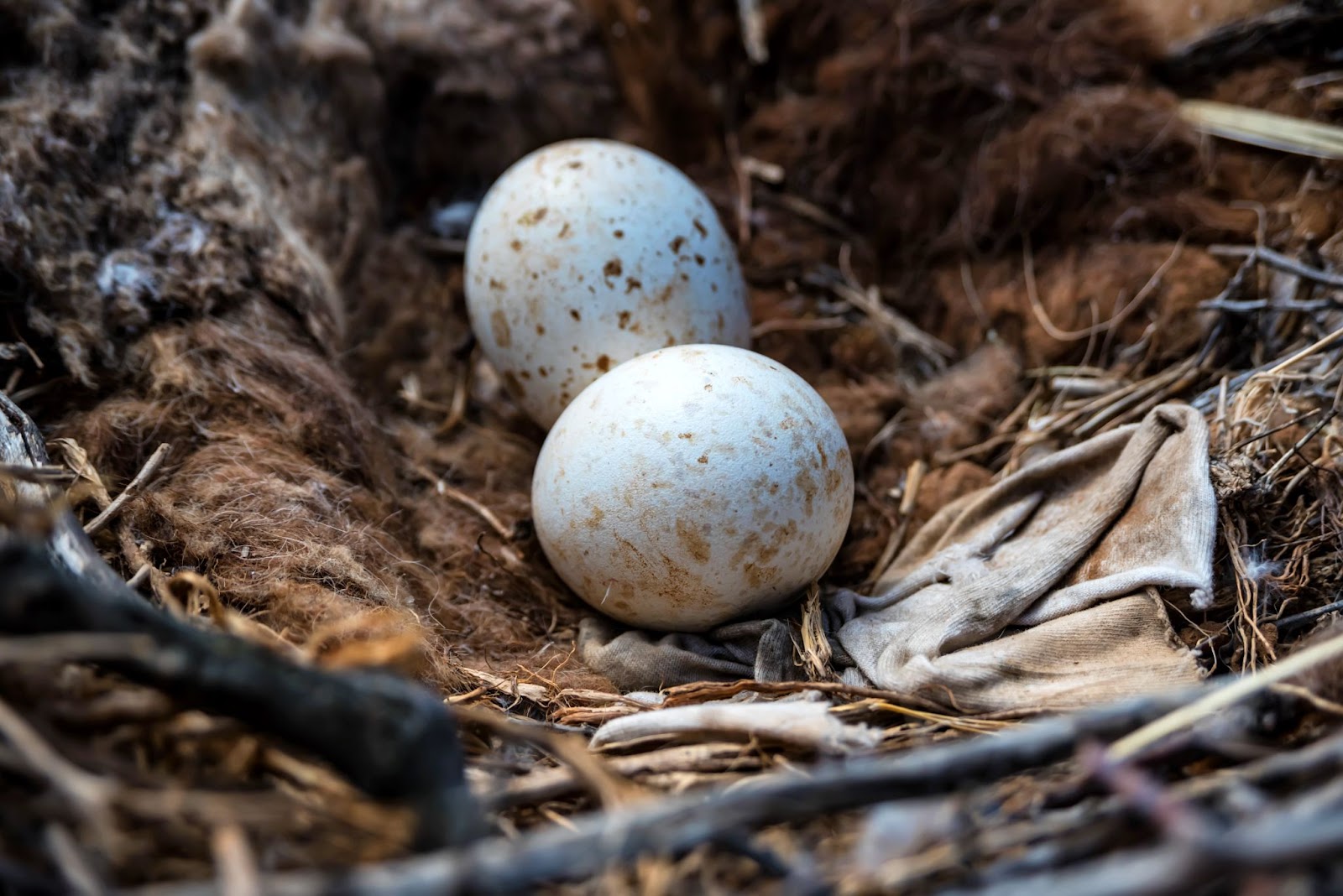
Once the female has laid her first egg, she sits on it. When the clutch is complete, and she has laid all her eggs, she then shares sitting on them with her partner. Sitting on eggs is called incubation. Incubation provides the eggs with the warmth necessary to form baby hawks.
Incubation lasts for four to five weeks, a period during which the couple takes turns hunting and bringing food to the other partner incubating the eggs at the nest. When it is time, eggs start to hatch.
Interestingly, the first to be laid is the first to hatch. Hatchlings are entirely vulnerable. They are so small, only weighing 57 g, closed-eyed, and have no feathers. They entirely depend on their parents for food, who take turns feeding them. Within a week of hatching, baby hawks will open their eyes and start recognising their environment, including their parents.
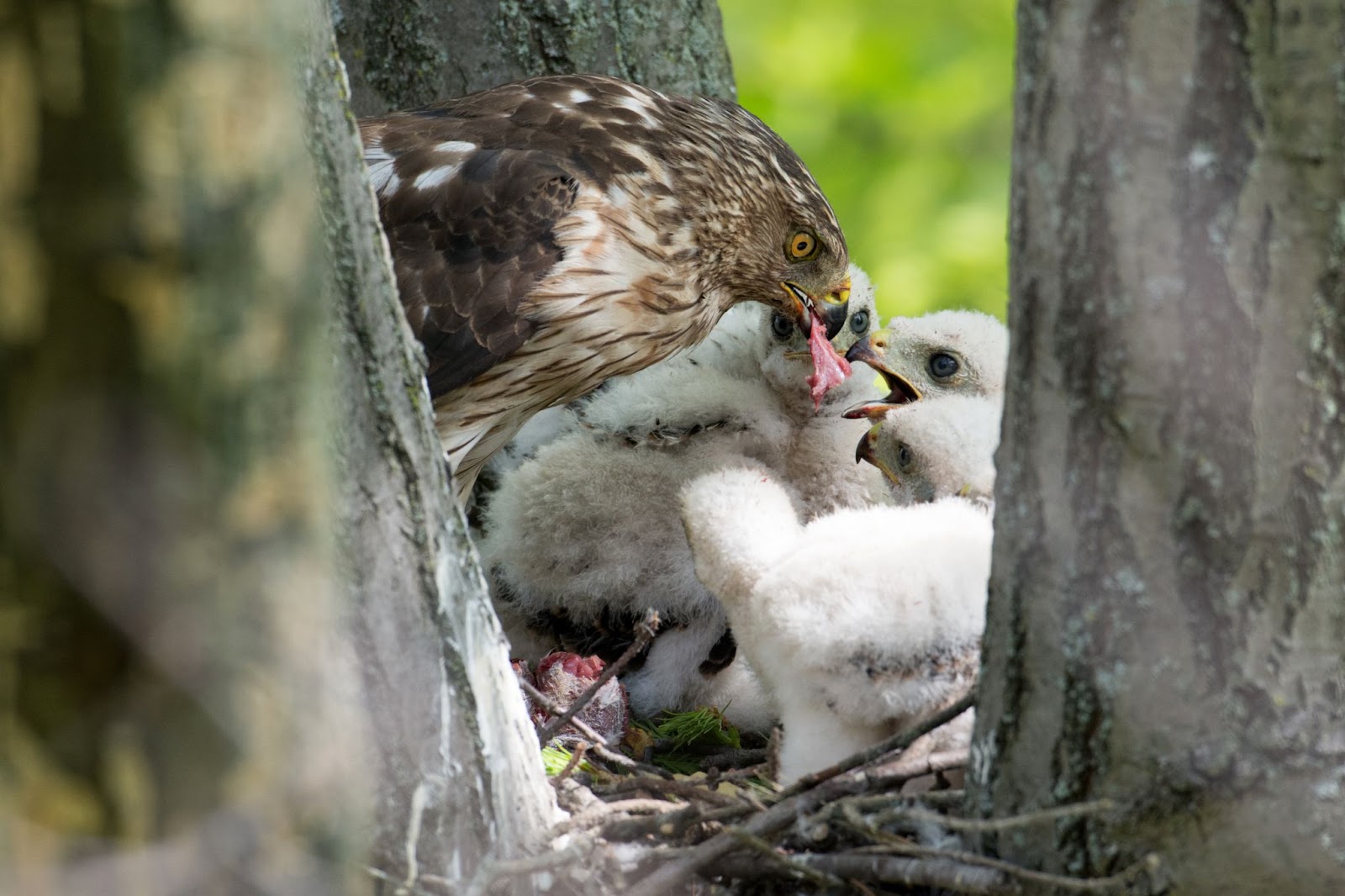
Parents feed their babies for four to eight weeks. During this time, chicks grow feathers. At first, the feathers have a white, creamy colour. As the chicks get older, their feathers gradually take hues of beige and brown. As they become more developed, the feathers become thicker, longer, and browner!
Then, chicks gradually learn to fly. When they are able to flap their wings, which must have become stronger by this time, they leave the nest. Thanks to their predatory instincts and their parents’ instructions, young hawks learn to hunt even before they have fully developed talons. Until this happens, they use their beaks to catch and kill prey.
As mentioned, hawks stay together for life. So the year after, the same couple from the year before will mate again and have new babies. Hawks live for 12 years on average in the wild. But their lifespan can be longer in captivity since there are natural or human-made threats. This may extend their lifespan to 20 years.
Some species, such as the red-tailed hawk, may even live up to 30 years.
Eyesight
While dogs are famous for possessing an excellent sense of smell, no one can ever discuss hawks without mentioning their amazing eyesight. As predatory birds, vision is hawks’ top asset.
Hawks are known to see eight times more clearly than us. They can see all the same light ranges as us, but they also see ultraviolet light, which the human eye cannot detect. In addition, hawks can see in colour.
Thanks to their eyes being on each side of their tiny heads, hawks enjoy a vision field of 280° compared to our 180° field. Besides the birds’ other traits, such incredible eyesight has made hawks excellent hunters. For instance, they can locate prey of a medium size from a 1.6 km distance.
Hunting
Typically, hawks fly and dive. Yet, diving does not mean they go underwater, but it describes flying diagonally downward toward prey. Thanks to their strong physique, powerful wings, and the force of gravity, hawks can dive at the speed of 240 km/h.
Such an incredibly high diving speed is one of the hawk’s advantages in catching prey. They dive swiftly and surprise animals from behind. And before the animal even understands what has happened, hawks catch it using their sharp talons.
Some hawk species kill their prey by squeezing it between their talons. Others use their sharp hooked beaks to kill it, tear it apart, and eat it.
Migration
Generally, most birds migrate. They leave their homes at certain times of the year, usually when the food is scarce, the weather is terrible, or to escape predators. They travel long distances to other areas that are safer and more abundant with food. And hawks are no different.
Most, but not all, hawks migrate. Migration generally depends on where the hawk lives and what this place is like in winter. If winter in the hawk’s original habitat happens to be harsh and the food is insufficient, it travels to another area that is warmer and where food is available.
There are two different seasons for migration. The first one starts in autumn as hawks leave their homes before winter hits. Hawks migrate in flocks from September and up until mid-November and sometimes even mid-December. They choose places with favourable weather conditions, stay there for the winter season, and then fly back home in the spring.
As migrating hawks usually travel long distances, they carefully get ready for the journey by feeding a lot and fattening up before they start migrating. Such increased body fat will maintain their physical strength and allow them to reach their destinations safely.
By that time, they indeed will have lost a lot of weight. But they always compensate for that by hunting in their new food-abundant home.
Scientists and researchers observed that many hawks prefer to migrate early in the season rather than later, which also means they will arrive early. Those who arrive first usually have better chances of finding food and choosing safer places to build their nests.
When the winter is over, hawks go back to their original habitat. In the spring, the mating season starts.
Another point that shows how intelligent hawks are is the route they choose when travelling to their new, temporary homes. They know, for sure, that bodies of water such as lakes, rivers, and seas are more likely to have wind currents. If the wind is aggressive, it might push the hawk away from its direction. If it is in the opposite direction, it will make it hard for the bird to fly.
This difficulty will consequently make the hawk exert more physical effort, burn more calories, lose much of its weight, and become weary before reaching its safe destination.
That is why hawks prefer to fly along borders instead of over a river. If they come across a lake, for instance, they often go around it. Though they travel a longer distance when they do that, it is nothing like facing strong wind.
Flocking
Hawks were also seen migrating in groups usually known as flocks. This is quite strange for birds that are not very social except at the family level. So why is this happening?
To understand this, we must go back a little to our lesson about Earth’s fantastic atmosphere. As the ground receives sunlight and heats up, the air that is right above the ground is then heated up too.
Usually, hot air is less dense than cold air. So hot air goes up and cool air goes down. When the cold air touches the ground, it heats up and goes up, and the hot air that has already cooled down goes down to the ground, and so on.
This circulation is known as air currents, in which hot air is always above the cold air. These columns of hot air are known as thermals.
As thermals usually go upward, they push hawks into the air without requiring them to flap their wings. In other words, thermals keep hawks in the air and preserve their energy simultaneously. This action of flying through the warm air is called soaring.
In addition, thermals were found to move upwards in spirals. So for the hawks to stay within thermals, they, too, have to move in circles.
When it is time to migrate, hawks stay attentive to thermals as they can carry them in the air and help them save energy. When a hawk finds thermals and starts moving in circles, other hawks immediately see and acknowledge this movement. They think, “There must be thermals over there. Let’s join them”.
So, that is how hawks travel in large groups or flocks: they take advantage of thermals in the air and attract one another like a magnetic field.
Screeching
Most animals use unique vocalisations to communicate with one another, and the hawk is pretty much the same. The hawk’s sound is generally called a screech or a scream.
Hawks screech in different situations and for several reasons. Most commonly, they screech to identify and defend their territory, usually while soaring.
But are hawks territorial in the first place? Well, somehow.
We know that many animals choose certain areas as their homes and mark them so as to inform others these are privately owned areas and to push away intruders. Some animals use their body scents to mark their territory. This way, others will know that and, hopefully, stay away.
Yet, hawks are different. They do not use scents to mark their territories but instead they fly over them. They watch their homes and frequently give sharp screams, each lasting for three seconds, which other hawks understand as keep-out messages. These screams are called flight screeches because hawks always make them while they are in the air.
Interestingly, hawks do not screech against other hawks or birds only. They will also send warning screams to humans if they happen to pass or drive through their territory.
If the hawk feels it is in danger or happens to be experiencing pain, it will also screech. Again, one cannot help but wonder if hawks ever get attacked, given that they are apex predators. Well, sometimes, under certain circumstances, hawks may get attacked even by smaller birds.
As reported by The Denver Post, a red-tailed hawk, which is a hawk species native to North America, was seen under attack by a small bird called the kingbird. Though it was only 3.27% the size of the hawk, the tiny kingbird was implanting its claws in the hawk’s back neck and feverishly pecking its head. The hawk screamed in pain and grabbed the attention of a birdwatcher who was attentive enough to take a clear picture.
In addition, hawks may be attacked by other larger hawks, owls, and eagles, which also happen to be extremely powerful birds of prey. So hawks will screech anyway if they experience any attack.
Screeches are made by adult hawks. As young hawks are still underdeveloped, their vocalisations are much weaker. But they can still make calls. During the feeding period, for instance, chicks may make a loud cry, especially if neither of the parents is at the nest, to tell them to come back quickly and feed them. “We are starving”, they say.
Hawks of different species may also produce different calls to defend their nests and nestlings. This is when hawks usually become aggressive and can potentially attack intruders, whether they are other birds or even humans. That said, hawk attacks on humans are still rare.
When hawks are at the nest, they tend to stay silent. Besides having almost no reason for giving calls, staying silent helps them stay safe, hidden, and protected from predators. If they give calls while in the nest, owls can locate and attack the nestlings. And if a parent hawk gets into a fight with an owl, the latter would always win as it is more powerful.
Falconry
Thousands of years ago, humans started interacting with animals. They feared some of them, like wolves and cheetahs. But they also domesticated others, such as cats, dogs, sheep, and cattle. And others they trained for their benefit, like hawks.
As we have displayed earlier, hawks are perfect hunters. Their highly developed eyes and excellent vision enable them to locate prey accurately. Then, they catch and squeeze it using their talons. So, when humans spotted these strong traits, they decided to dedicate them to their own benefit.
If hunting wild animals is hard and dangerous, why not train hawks to do it for them?
Such a sport is called hawking. It is not precisely known when humans started such a practice. However, it is widely believed that our ancestors had already done it thousands of years ago. Somehow, they found a way to train hawks to hunt animals in their original habitat and bring them back.
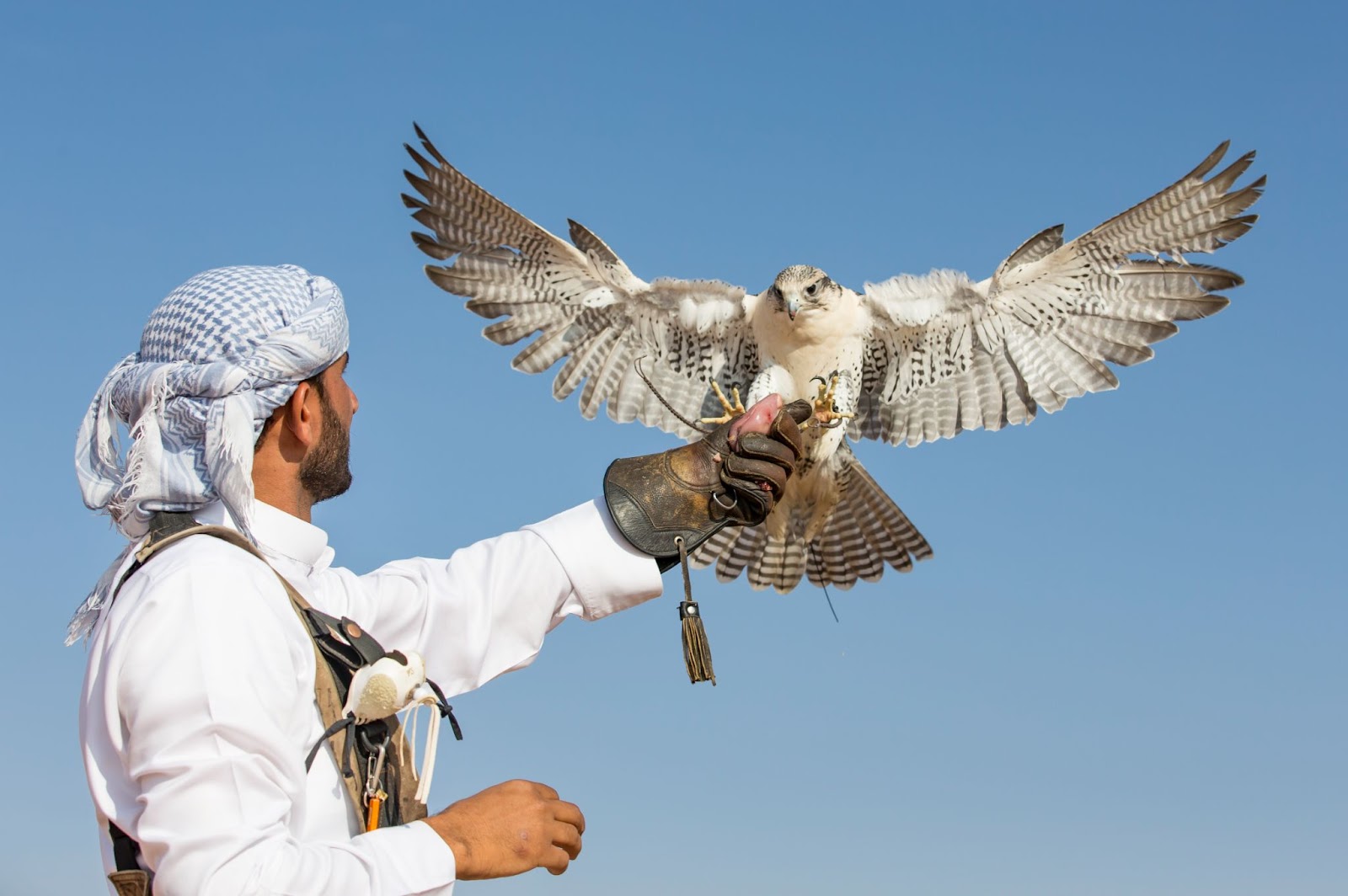
Interestingly, it is not just hawks that humans use for hunting. Falcons, eagles, and other birds of prey are used for that sport. In that way, any bird used for that very purpose can be called a hawk, even though it is not a hawk.
That said, many people may also refer to this sport as falconry. So the person who practises falconry is called, yes, a falconer.
Conclusion
And so we get to the end of today’s adventure, where we explored the world of one of the most powerful raptors, the hawk.
Hawks are those strong predatory birds that are found on every continent except for Antarctica. There are over 250 hawk species currently living on Earth. Despite every species possessing different traits, all hawks have many common characteristics.
Then, we moved to the hawk’s breeding behaviour. After hawks attract their partner by soaring in the air and showing off their aerial skills, they mate, breed, lay eggs and incubate.
Hawks are perfect hunters who have been blessed by a set of physical traits that manifests these hunting skills. They have a super sharp vision that is eight times clearer than the human vision. They have razor-sharp curved claws that allow them to catch prey. Their hooked beaks also enable them to tear prey apart.
Hawks are highly protective of their offspring, nests, and territories. They screech to deliver different messages to other hawks, the most common of which is not to come any closer.
Last but not least, we discussed how humans take advantage of hawks through falconry. For years on end, humans have trained hawks to catch wild animals and bring them back to them. Interestingly, not only hawks are used for falconry, but many other birds of prey too, such as eagles.
We hope you enjoyed today’s lesson about hawks as much as we loved writing it for you. Tell us in the comments what you liked the most about the hawk and which part of the lesson you found the most interesting.
If you enjoyed learning about this fascinating animal, why not check out more fantastic facts about other animals: Koalas, Land Animals, Sharks, Raccoons, Moon and Sun Bears, Rats, Chickens, Cats, Pandas, Monkeys, endangered animals, waterfowl and Whales.
Why not subscribe to our LearningMole Library for as little as £1.99 per month to access over 1400 fun educational videos.


Leave a Reply